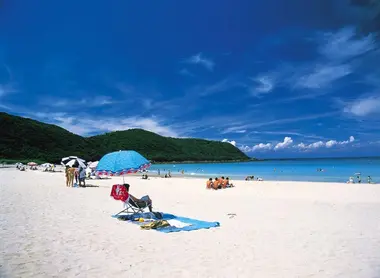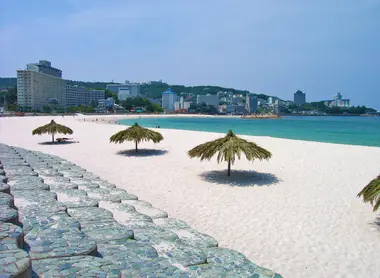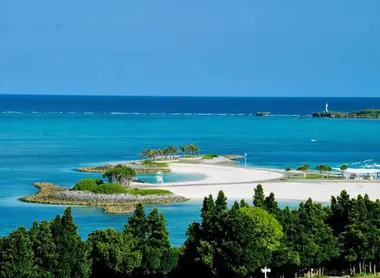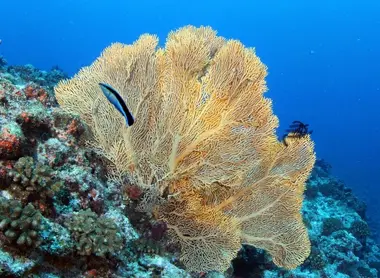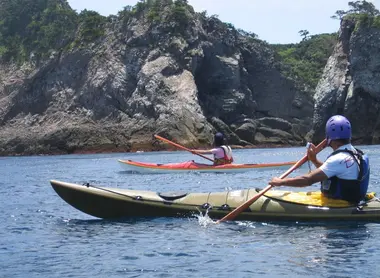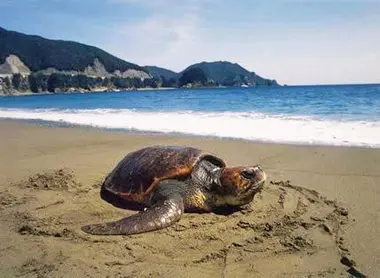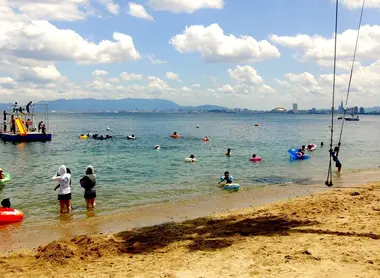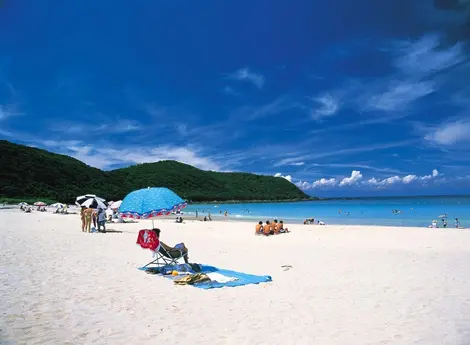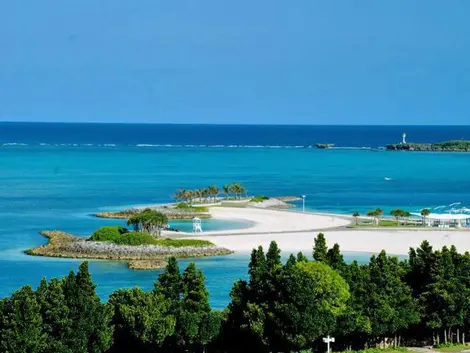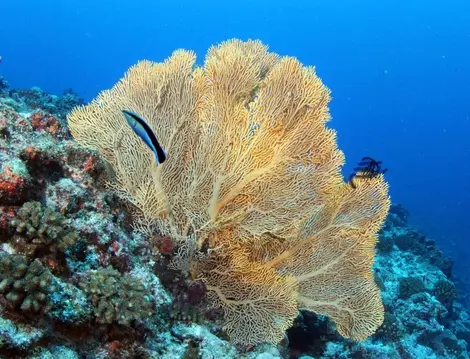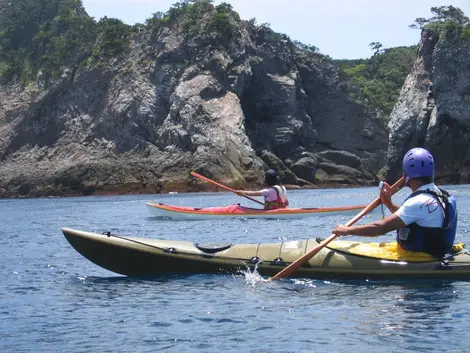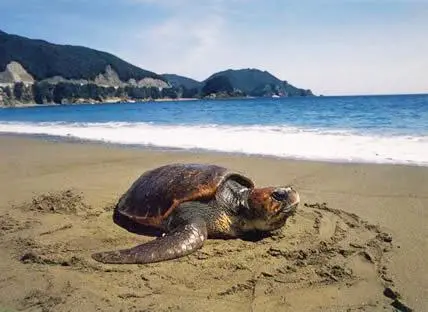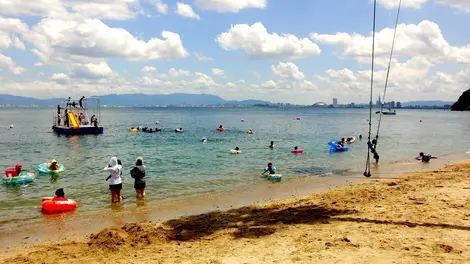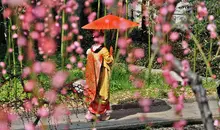Japan by the Beach
- Published on : 16/10/2014
- by : C.W.
- Youtube
Tan in the Rising Sun
Japan, often celebrated for its thousand-year-old culture and mountainous landscapes, hides a veritable coastal treasure trove with over 30,000 kilometers of coastline. From the far north to the tropical islands of the south, the Japanese archipelago offers a surprising diversity of beaches, often overlooked by Western travelers. Far from being a mere cultural destination, Japan offers unique seaside experiences, marked by specific traditions and breathtaking landscapes. From the white sands of Okinawa to the intimate coves of Shikoku, each region reveals a different face of coastal Japan, inviting discovery off the beaten track.
Japanese beaches: unsuspected diversity by region
Despite its image as an urban, mountainous country, Japan is surprisingly rich and varied in terms of its beaches, which vary considerably from region to region. In the subtropical south, the Okinawa archipelago offers beaches worthy of the most beautiful postcards, with their immaculate white sand and turquoise waters. Emerald Beach, on the north coast of Okinawa's main island (Honto), is one of Japan's few lagoon beaches, enclosed offshore by a magnificent coral reef. This free beach, over 500 metres long, is located inside the Ocean Park Expo, which also features an aquarium and museum.
Moving up towards central Japan, on the main island of Honshu, we discover beaches that are more temperate but just as charming. The Kii peninsula, which stretches between southernOsaka and the Ise sanctuary, is home to the famous Shirahama beach. This magnificent arc of "white sand" (meaning "shira-hama") is surrounded by renowned spas and offers a unique experience: the Saki no yu Onsen, one of Japan's oldest and most revered baths, allows you to contemplate the ocean while relaxing in an open-air hot-water pool.
Further north, the Izu peninsula, formed in part by the eruptions of Mount Fuji, is a popular holiday destination for Tokyoites. Yumigahama, a long pine-fringed beach stretching for 1 km near Shimoda, is the ideal destination for summer picnics and beach bonfires. Its neighbor Shirahama attracts more families, while Yumigahama is frequented by a younger population.
When to visit Japanese beaches: understanding the bathing seasons
Beach-going in Japan follows a well-defined calendar, which may come as a surprise to Western visitors. Contrary to our habits, there is a real "bathing season" which officially begins with a ceremony called umi biraki (opening of the sea). This unique tradition bears witness to the special relationship the Japanese have with nature and the seasons.
In Okinawa, the bathing season starts as early as March or April, thanks to its subtropical climate, while the beaches of the Kanto region (around Tokyo) don't usually open until July. Visitor numbers start to drop in mid-August with Obon, the annual celebration of the ancestral spirits. This is also the period when jellyfish begin to appear.
A surprising phenomenon occurs from September 1st (outside Okinawa): even if the weather remains sunny and warm, the beaches suddenly empty. All you'll find are a few foreigners, brave surfers or locals walking their dogs. Although the beaches are not physically closed, temporary facilities such as umi no ie (beach huts) are dismantled and the lifeguards leave, marking the official end of the season.
To enjoy Japanese beaches to the full, we recommend visiting Shirahama (Kii Peninsula) in May, June or September, to avoid the summer crowds. For the beaches of Izu, the best period is from June to September. As for Okinawa, late spring to mid-May and early autumn offer milder weather, while avoiding the tourist crowds of the summer months.
Customs and practices on Japanese beaches
Japanese beaches are governed by specific cultural codes that are important to know for a harmonious experience. Unlike in Western countries, spending an entire day sunbathing is not an established practice in Japanese culture. Only a fraction of the population - mainly young people, local residents of seaside resorts or, more recently, families - indulge in this activity.
The Japanese are very concerned about the damage caused by UV rays, as white skin is traditionally considered a symbol of beauty. Some prefer to keep their shirts on on the beach, and even cover up from head to toe. However, this is by no means an obligation for foreign visitors - a classic swimsuit is perfectly acceptable!
An important point concerns tattoos, which are still viewed negatively in Japanese culture due to their historical association with the yakuza (Japanese mafia). Few beaches completely ban tattoos, but a few, such as Zushi beach near Tokyo, do. It's advisable to find out in advance, and to cover the most visible tattoos with waterproof clothing or bandages.
Although nudity is the rule in Japanese public baths, it is not tolerated on beaches, even if it only involves revealing the breasts. It's also advisable to wear a T-shirt as soon as you leave the beach.
As everywhere else in Japan , garbage cans are rare in public spaces, which nonetheless remain exemplarily clean. Everyone is expected to take their own garbage home with them, so it's a good idea to bring a bag with you. Finally, the Japanese have developed their own beach activities, the most picturesque of which is suikawari, a tradition consisting of breaking a watermelon on the ground with a stick, blindfolded and after making several turns on oneself.
The best beaches in Okinawa and the southern islands
TheOkinawa archipelago, located in the extreme south of Japan, is a veritable tropical paradise, home to some of the country's finest beaches. Its subtropical climate, crystal-clear waters and relaxed atmosphere make it the ideal seaside destination for travellers looking for a change of scenery.
The island of Miyako, around 300 km from Okinawa, is famous for its Yonaha-Maehama beach, with its turquoise waters and fine white sand offering a panorama worthy of the Caribbean. On the same island, Sunayama beach offers ideal conditions for swimming, snorkeling and scuba diving. Its subtropical climate makes it a year-round seaside destination.
Kabira Bay on Ishigaki Island is one of Japan's most impressive landscapes, with its combination of crystal-clear water, lush vegetation and white sandy beach. Although it's not possible to swim here due to the strong currents, glass-bottom boat excursions allow you to admire the extraordinary underwater world.
In the heart of the Kerama archipelago, the island of Zamami, with its magnificent coral beach and Ama's crystal-clear waters, invites you to a dream vacation. Snorkeling and diving enthusiasts will be able to observe giant sea turtles, especially between January and March, as well as multicolored fish near the fantastic coral reef.
Tokashiki Island, also in the Kerama archipelago, is home to the spectacular Aharen beach. From May to October, conditions are optimal for an unforgettable seaside vacation. The fine white sand, gently sloping turquoise sea and lush vegetation in the background create a heavenly backdrop for swimming, sunbathing or diving.
Beaches accessible from Tokyo and major cities
For travelers based in Tokyo or Japan's major cities who want to enjoy a seaside getaway without having to travel long distances, there are several options. These beaches, easily accessible by train or bus, combine cultural visits with seaside relaxation.
Less than an hour and a half from Tokyo by train, the beaches of Kamakura, the Hayama Coast and the southern beach of Chigasaki are among the most popular with city dwellers. On these sites, you'll find umi no ie, beach huts often built of wood and offering various services such as equipment rental, lockers, showers, food and drinks. It's the ideal place to sample Japanese summer culinary favourites such as yakisoba (fried noodles) or kakigori (crushed ice in syrup).
Yumigahama beach, at the southern tip of the Izu peninsula, is often referred to as "Tokyo's Deauville". Easily accessible from the capital, this long, pine-lined beach is particularly appreciated for its youthful, vibrant atmosphere, ideal for picnics and beach bonfires in summer.
For those staying in Fukuoka, the small island of Nokonoshima, located in the middle of Hakata Bay, offers easily accessible beaches (10-minute ferry ride from Meinohama pier). Although not the wildest, these beaches are a welcome escape from the city's industrious atmosphere. In the distance, you can even see Fukuoka's skyscrapers, notably the slender Fukuoka Tower.
From Odaiba in Tokyo, the artificial polder invites you to enjoy an exceptional travel experience with its many small bays. Although swimming is not recommended, a variety of sporting and cultural events, as well as numerous stores and restaurants, keep visitors entertained. In the early evening, you can admire the sunset against the impressive backdrop of the Tokyo skyline.
Activities and facilities: what to expect on Japanese beaches
Japanese beaches offer much more than simple stretches of sand on which to bask. Depending on the region, facilities and activities vary considerably, offering a wide range of experiences to suit all tastes.
On the most popular beaches, you'll usually find lifeguards on duty to ensure the safety of bathers during the official season. Facilities such as toilets, showers and sometimes stores for renting or buying equipment are also available. In summer, the famous umi no ie (temporary beach houses) set up on the sand, offering various services such as equipment rental, lockers, showers and, above all, food and drink.
For water sports enthusiasts, several areas stand out for their excellent conditions. The beaches of Chiba, Izu, Niijima and Miyazaki are renowned for surfing, attracting enthusiasts from all over the world. If you prefer scuba diving, Okinawa's seabed, with its vibrant coral reefs and incredible biodiversity, offers exceptional spots.
Beyond the classic activities, some beaches offer unique experiences. For example, near Shirahama on the Kii Peninsula, the Saki no yu Onsen allows you to enjoy an open-air thermal bath while contemplating the ocean. On the island of Nokonoshima, you can admire the fabulous flowerbeds (daffodils, cosmos, etc.) for which its gardens are famous.
As municipalities offer little in the way of beach entertainment, Japanese summer visitors often bring their own. Suikawari, the tradition of breaking a watermelon blindfolded, is one of the most emblematic rituals of Japanese summer vacations, alongside the fireworks that regularly light up the summer nights.
Hidden gems: confidential beaches and unique experiences
In addition to the best-known and most popular beaches, Japan also boasts a number of coastal treasures that have remained untouched by mass tourism. These more confidential spots offer an authentic and often more peaceful experience, perfect for travelers in search of tranquility.
On the island of Shikoku, particularly on the south coast, which is less crowded than the larger northern cities such as Takamatsu or Matsuyama, lies the pretty beach of Asakawa Ozuna. Even in the middle of August, bathers are guaranteed peace and quiet. Despite its low number of visitors, the beach offers a wide range of facilities (parking, showers, toilets, automatic lockers). For surfers, the waves can be found a little further away, to the south near Kaifu (the mecca of Japanese surfers) or to the north towards Tainohama.
The island of Shikinejima, one of the smallest islands in the Izu archipelago, enchants with its unique landscapes and beaches that are among the most beautiful in Japan. Accessible by ferry from Tokyo (crossing takes around three hours), this picturesque island is ideal for exploring by bike. Far from the noise of the big cities, it's the perfect place to enjoy spectacular scenery and unspoilt nature.
The Kii peninsula, to the south of Osaka, abounds with lesser-known beaches just as charming as the famous Shirahama. As you head towards Kushimoto, you'll discover wild coves and beaches that are less well-equipped but also less frequented.
Yurigahama, a tropical sandbank in front of Yoron Island, offers a truly unique experience. This natural phenomenon is only visible at low tide, in spring or summer. You can reach it by ferry to enjoy the snow-white sand and breathtaking views of the surrounding turquoise sea. For the rest of the year, Yurigahama disappears beneath the waves.
On the island of Amami Oshima, the largest island in the Satsunan archipelago, Tomori beach captivates with its white sand, azure waters and idyllic atmosphere. It's an ideal place to explore the colorful underwater world, swim in the crystal-clear waters or simply soak up the sun on the fine sand.
